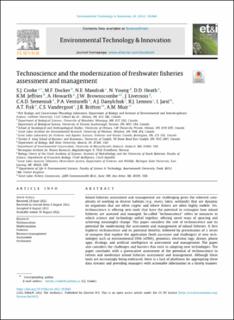Technoscience and the modernization of freshwater fisheries assessment and management
Cooke, S.J.; Docker, M.F.; Mandrak, N.E.; Young, N.; Heath, D.D.; Jeffries, K.M.; Howarth, A.; Brownscombe, J.W.; Livernois, J.; Semeniuk, C.A.D.; Venturelli, P.A.; Danylchuk, A.J.; Lennox, Robert; Jarić, I.; Fisk, A.T.; Vandergoot, C.S.; Britton, J.R.; Muir, A.M.
Peer reviewed, Journal article
Published version

Åpne
Permanent lenke
https://hdl.handle.net/11250/3054592Utgivelsesdato
2022Metadata
Vis full innførselSamlinger
- Publikasjoner fra CRIStin - NINA [2364]
- Scientific publications [1392]
Sammendrag
Inland fisheries assessment and management are challenging given the inherent com-
plexity of working in diverse habitats (e.g., rivers, lakes, wetlands) that are dynamic
on organisms that are often cryptic and where fishers are often highly mobile. Yet,
technoscience is offering new tools that have the potential to reimagine how inland
fisheries are assessed and managed. So-called ‘‘technoscience’’ refers to instances in
which science and technology unfurl together, offering novel ways of spurring and
achieving meaningful change. This paper considers the role of technoscience and its
potential for modernizing the assessment and management of inland fisheries. It first
explores technoscience and its potential benefits, followed by presentation of a series
of synopses that explore the application (both successes and challenges) of new tech-
nologies such as environmental DNA (eDNA), genomics, electronic tags, drones, phone
apps, iEcology, and artificial intelligence to assessment and management. The paper
also considers the challenges and barriers that exist in adopting new technologies. The
paper concludes with a provocative assessment of the potential of technoscience to
reform and modernize inland fisheries assessment and management. Although these
tools are increasingly being embraced, there is a lack of platforms for aggregating these
data streams and providing managers with actionable information in a timely manner.
The ideas presented here should serve as a catalyst for beginning to work collectively
and collaboratively towards fisheries assessment and management systems that harness
the power of technology and serve to modernize inland fisheries management. Such
transformation is urgently needed given the dynamic nature of environmental change,
the evolving threat matrix facing inland waters, and the complex behavior of fishers.
Quite simply, a dynamic world demands dynamic fisheries management; technoscience
has made that within reach.
